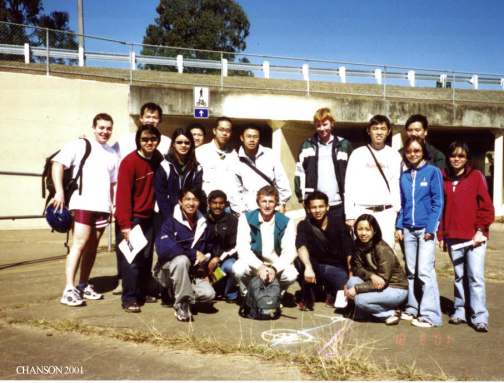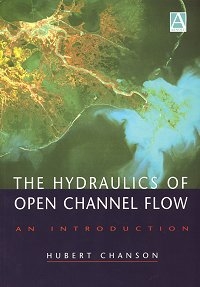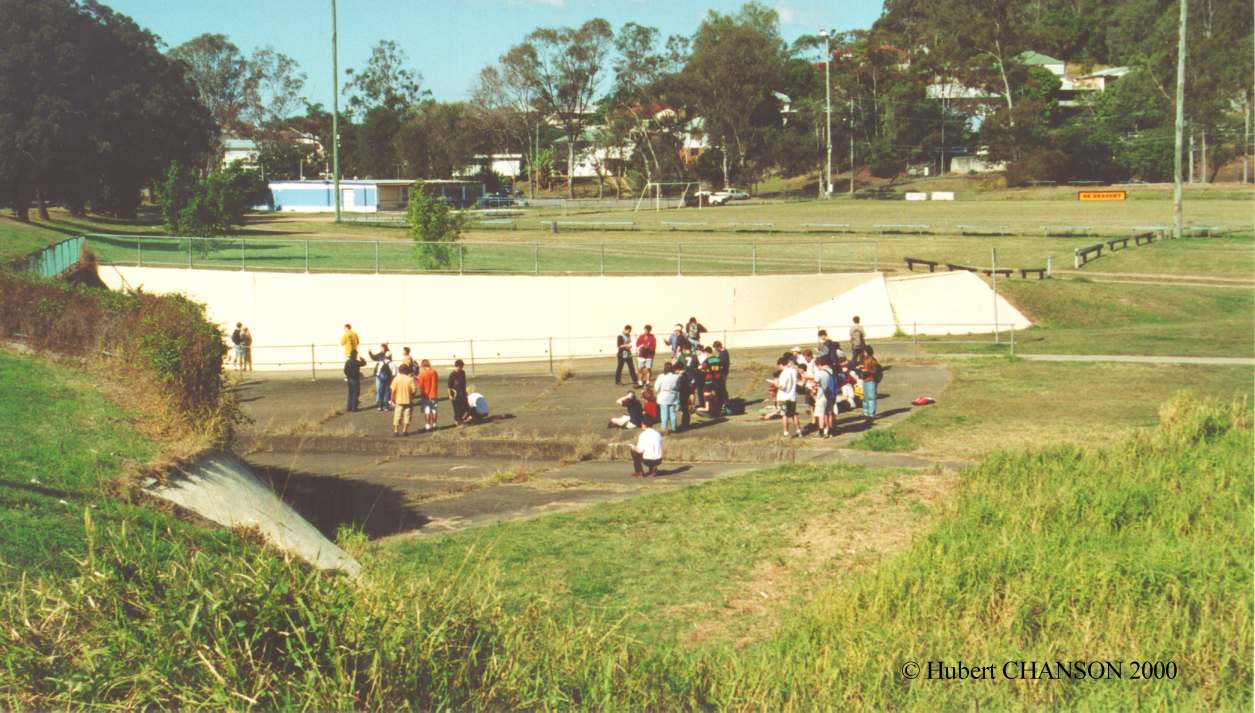 MEL culvert outlet. Field trip in Aug. 2001 with CIVL3120 class
MEL culvert outlet. Field trip in Aug. 2001 with CIVL3120 class Syllabus
Syllabus
Advanced open-channel hydraulics & applications: Introduction to watershed, groundwater & hydraulic modelling.
Subject rationale: The aim of the subject is to develop a sound understanding of the hydraulic design of civil engineering structures. Fundamental fluid mechanics principles are applied to professional water engineering problems.
Subject goals: The subject CIVL3120 is a professional subject in which the students learn how to apply fundamental principles to practical situations. The design of a hydraulic system is based on a system approach. The hydraulic structure must be analysed as part of the surrounding catchment and the hydrology plays an important role. Structural and hydraulic constraints interact, and the design of a hydraulic structure is a complex exercise altogether. First the system must be identified. What are the design objectives ? What are the constraints ? What is the range of options ? What is the "best choice" ? Its detailed analysis must be conducted and the engineers should ask : is this solution really satisfactory ? During design stages, physical and computational models may be reliable 'tools' to compare the performances of various design options.After completion of the subject, each student will know how to apply the fundamental fluid mechanics principles to professional designs and they will be familiar with the multi-disciplinary aspects of an engineering project.
The subject is the second of a series of three subjects (CIVL3110, CIVL3120 and CIVL4120) dealing with hydraulic structures and their interactions with the environment.Catchment Hydrology : {http://www.uq.edu.au/~e1wclark}
+ CHANSON, H. (1999). "The Hydraulics of Open Channel Flows : An Introduction." Butterworth-Heinemann, Oxford, UK, 512 pages (ISBN 0 340 74067 1). {Support website : http://www.bh.com/companions/0340740671} Corrections & Updates [ Newsletters No. 1, No. 2]Review by Professor Ö. STAROSOLSZKY, Director, VITUKI, in Jl of Hyd. Res., IAHR, 2001, Vol. 39, No. 1, pp. 331-332. {Read Full Review}
"The author has made a great effort to help the reader to understand both the theory and its applications. The reviewer congratulates him for his oriignal approach, which makes the booke qually valuable both for students, and also practitioners in hydraulic engineering. [...] Excellent photographs of particular structures illustrate point sraised in he text. [...] The book should serve as a valuable textbook for students of hydraulic engineering, as well as for hydrologists concerend with surface waters."Review by Professor P. BATES, University of Bristol. "Changing a winning formula: the hydraulics of open channel flow: an introduction." in Hydrological Processes, Vol. 15, No. 1, Special Issue, 2001, pp. 159-161. {Read Full Review}
"Hubert Chanson's book meet some of the needs for an open channel text in environmental hydraulics. [...] When discussing hydraulics or sediment transport, each section is structured in highly logical manner. Physical properties are discussed initially, followed by a consideration of the basic dynamic equations. In both cases, these descriptions are extremely clear. These sections are also both admirably comprehensive. The ultimate test of such a textbook is whether it can be useful for a range of problems and be accessible to a wide readership. To do this the hydraulics group at Bristol has been 'road-testing' this volume for the past three months. [...] In that time, a diverse range of queries has been initially researched in Hubert Chanson's volume, and it has passed each test with flying colours. All graduate and postdoctoral researchers who have used the volume have commented favourably on its clarity and completeness, and I can think of no better recommendation than this. This is an excellent book for undergraduate and graduate students in civil engineering interested in open channel flow, and a very useful resource text for those interested in hydraulics outside engineering field."Review by Professor S.N. LANE, University of Leeds, in Environmental Conservation, Volume 27 2000, Issue 3, pp 314-315. {Read Full Review}
"Without a doubt, this is the best introduction to the introduction of the hydraulics of open channel flow that I have yet to read. The text deserves special credit for the explicit identification of the assumptions that exist behind relationships, something that can be (and is) easily over-looked by students whilst using other texts. As an introduction to the hydraulics of open channel flow, I would find it difficult to recommend anything that could improve upon the approach adopted. My overwhelming conclusion is that as an introduction to the hydraulics of open channel flow, it would be impossible to produce a better result. This will appear on both my undergraduate and postgraduate reading lists as the core text. It is rare for me to be so readily persuaded, and Dr Chanson deserves full credit for an outstanding teaching resource."Review by Professor D.A. ERVINE, Univwersity of Glasgow, in Chemical Engineering Research and Design, Trans IChemE, Part A, Vol 78, Number A7, Oct. 2000, pp 1055.{Read Full Review}
"Hubert Chanson's latest book is really designed for a Civil Engineering readership with its emphasis on sediment movement in rivers and also hydraulic structures for rivers and dams. All in all, a well constructed book with many helpful examples and explanations for the student."Review by Professor W.H. HAGER, ETH-Zurich (Switzerland) in Wasser, Energie & Luft, 2000, Switzerland, No. 1/2, p. 55 :
"The author has succeeded in producing yet another excellent piece of work. [...] All in all, this is a well-written and carefully illustrated book which is useful for all civil and environmental engineers. Having an elaborate bibliography, an index of authors and an index of subjects as well as a description of project examples, it easily meets highest expectations."Review by Dr L.J. WEBER, University fo Iowa (USA), Jl of Hyd. Engrg., ASCE, 2001, Vol. 127, No. 3, pp. 246-247. {Read Full Review}
"The strength of the book is its breadth of coverage. Containing a wealth of information, as well as being appropriate for an advanced undergraduate course on open channel hydraulics, the book delivers a very good cross section of topics. The number of exercises is very impressive and worth the book's cost."Review by Professor M. JOVANOVIC, University of Belgrade, Urban Water, Vol. 1, No. 3, p. 270. {Read Full Review}
"This book stands apart from similar previously published textbooks in two ways. Firstly, its scope has significantly been extended toward applications. Secondly, by including many exercises,notes, discussions, relevant photographs,and appendices with additional information, it has an original, hand-book-like presentation, very convenient for quick referencing, and use in engineering practice. Being more than a simple introductory textbook in open channel hydraulics, this book can be strongly recommended to students and engineers."
+ APELT, C.J. (1983). Hydraulics of Minimum Energy Culverts and Bridge Waterways, Australian Civil Engrg Trans., I.E.Aust., Vol. CE25, No. 2, pp. 89-95.+ CHANSON, H. (2000). Introducing Originality and Innovation in Engineering Teaching: the Hydraulic Design of Culverts, European Journal of Engineering Education, Vol. 25, No. 4, pp. 377-391.
+ Introduction to Catchment Hydraulics, CIVL3110 website
+ Environmental Hydraulics, CIVL4120 website
+ Softwares : HydoCulv and HydroChan by Hydrotools software+ Catchment Hydrology {http://www.uq.edu.au/~e1wclark}
Box culvert calculations
Hydraulic calculations of upstream head above invert bed for box
culverts
with Inlet Control (Concrete Pipe Association of Australia 1991)
(DOUBLE-CLICK for full size
.WMF
file)
Hydraulic calculations of total head losses for concrete box culverts
flowing full (i.e. drowned) (Concrete Pipe Association of
Australia
1991) (DOUBLE-CLICK for full
size .TIF file)
Alternative : .PDF
file (both charts)
More photographs of culverts ...More about the design of Minimum Energy Loss culverts and bridge waterways ...
 MEL culvert outlet. Field trip in Aug. 2001 with CIVL3120 class
MEL culvert outlet. Field trip in Aug. 2001 with CIVL3120 classAdvanced Hydraulics
Physical modelling (30/7/2001)
Culvert design (20/7/2001)Text book exercises : http://www.bh.com/companions/0340740671/exercises/.
Hydraulic design
General information & Experiment description
Time schedule
Laboratory work is closely linked with the lecture program and it is an integral part of the hydraulics course. The students conduct two experiments on culvert design and backwater effects in a long channel. The main purpose of the first experiment is to understand the differences between the hydraulic performances of two different types of culverts carrying the same flow rate. The purpose of the long channel experiment is to demonstrate open channel control features, and to quantify friction and backwater effects in waterways. In each case, the experimental procedure includes observations, prediction (numerical modelling) and evaluation (comparison between data and computations).
Rating : [***] = superb, must see - [**] = excellentGeneral
Rivers Seen from Space [**]Basic Fluid Dynamics
Structurae, International Database and Gallery of Structures [**]Gallery of Photographs in Fluid Mechanics, Hydraulic & Environmental Engineering and Engineering History
ASME Database (American Society of Mechanical Engineers)
The Formal Water Garden
Gallery of photographs in fluid dynamics by Mark Kramer [**]Hydrology/Weather
National Weather Service Office of HydrologyRiver engineering
El Niño Information in California
Extreme reservoir siltation in Australia
The tidal bore of the Seine riverComputational modelling in hydraulics
Artifical river habitats and fish passes (photographs)
Flood plains (photographs)
Photographs of River Floods in Australia [**] (Search for : floods)
Aerial photographs of American rivers and valleys [**]
SoftwaresDam engineeringHydrochan(TM) [**] Gradually-varied flows (1D)
US Army Corps of Engineers HEC Softwares
ICOLD (International Commission on Large Dams)Spillway design and operation
Dams Safety Committee of New South Wales AustraliaBureau of Reclamation Concrete Dams
US Army Corps of Engineers Reservoirs in Pittsburgh's district
US Army Corps of Engineers, Walla Walla district [Photographs are listed Here]
US Army Corps of Engineers, Portland district, Photofile [**]
Gabion hydraulic structures (small dams, weirs) [Maccaferri]
Steel dams
Timber Crib Weirs in Queensland, Australia
History of arch dams
Rubber dams
The Minimum Energy Loss (MEL) weir design
California 1997 Flood ImagesAir entrainment on chutes spillways
Spillway Aeration Devices to prevent Cavitation Damage in high-head chutes {http://www.uq.edu.au/~e2hchans/aer_dev.html}
Stepped spillwaysWorld's oldest stepped spillway (Greece)
Santa Cruz dam stepped spillway (USA)
Greeley spillway (USA) [*]
Stepped spillway photographs
Embankment overflow stepped spillways: earth dam spillways with precast concrete blocks
Water quality issues
Chicago Calumet waterway: sidestream aeration cascadesAustralian
Petit-saut dam (French Guyana): aeration cascade
Petit-Saut dam : photographs, dam details
Bureau of MeteorologyResources
Goulburn-Murray Water
Hydro-Electric Corporation (Tasmania)
Murray-Darling Basin Commission
NSW Department of Land and Water Conservation
QLD Department of Natural Resources [Water, Storages]
University of Queensland LibraryThis page was visitedMeasurement systems : SI Units and significant figures
Internet resources in Hydraulic Engineering : rubber dams, tidal bore, reservoir siltation, MEL culverts ...
ICEnet: The Institution of Civil Engineers, UK Homepage
Japan Society of Civil Engineers
ASCE - American Society of Civil Engineers Homepage
ASME - American Society of Mechanical EngineersENPC - Ponts et Chaussees
IAHR homepage (International Association for Hydraulic Research)US Geological Survey
Civil Engineering Resources on the Internet (GuideMe.com)
| Back to Dr Chanson's Home Page |
|
|
Back to TOP
Back to Dr Hubert CHANSON's Home Page
 MEL culvert inlet. Field trip in Aug. 2000 with E2321 class
MEL culvert inlet. Field trip in Aug. 2000 with E2321 class